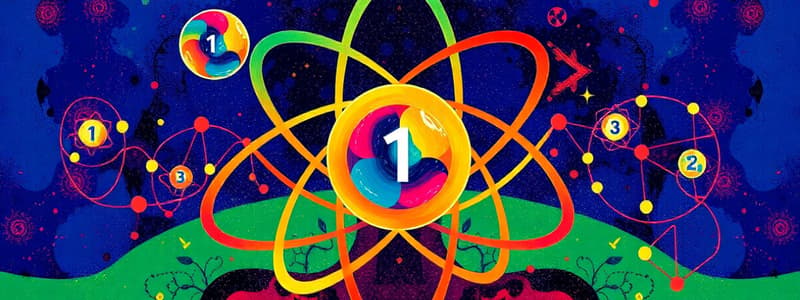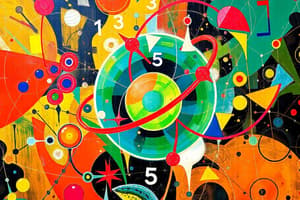Podcast
Questions and Answers
Which quantum number primarily determines the main energy level of an electron?
Which quantum number primarily determines the main energy level of an electron?
- Magnetic quantum number
- Principal quantum number (correct)
- Spin quantum number
- Second quantum number
What does the second quantum number primarily describe?
What does the second quantum number primarily describe?
- Orientation of the electron orbit in space
- Spin of the electron
- Main energy level of the electron
- Shape of the electron orbit (correct)
The magnetic quantum number describes the energy levels, primarily the shape of the electron orbit.
The magnetic quantum number describes the energy levels, primarily the shape of the electron orbit.
False (B)
For a principal quantum number $n = 3$, how many sublevels are possible?
For a principal quantum number $n = 3$, how many sublevels are possible?
Which quantum number describes the orientation of an electron's orbit in space?
Which quantum number describes the orientation of an electron's orbit in space?
If the second quantum number $l = 1$, what are the possible values for the magnetic quantum number $m_l$?
If the second quantum number $l = 1$, what are the possible values for the magnetic quantum number $m_l$?
The spin quantum number can only have values of +1/2 or ______.
The spin quantum number can only have values of +1/2 or ______.
What property of an atom does the spin quantum number relate to?
What property of an atom does the spin quantum number relate to?
Ferromagnetism is a type of magnetism seen in individual atoms with a relatively weak attraction to a strong magnet.
Ferromagnetism is a type of magnetism seen in individual atoms with a relatively weak attraction to a strong magnet.
Which of the following is a characteristic of paramagnetism?
Which of the following is a characteristic of paramagnetism?
Match the quantum number with its description:
Match the quantum number with its description:
According to the information provided, what are the two possible spin values for an electron?
According to the information provided, what are the two possible spin values for an electron?
If $l=0$, the only possible value for $m_l$ is 1.
If $l=0$, the only possible value for $m_l$ is 1.
If $l=2$, how many possible values of $m_l$ exist?
If $l=2$, how many possible values of $m_l$ exist?
What is the range of values for $m_l$ for a given value of $l$?
What is the range of values for $m_l$ for a given value of $l$?
Which of the following statements is true regarding the relationship between electron spins and magnetism?
Which of the following statements is true regarding the relationship between electron spins and magnetism?
An opposite pair of electron spins, regardless of orientation, will always produce magnetism.
An opposite pair of electron spins, regardless of orientation, will always produce magnetism.
Based on the materials, what condition is required for substances to produce no magnetic field?
Based on the materials, what condition is required for substances to produce no magnetic field?
What is required to fully describe an electron in an atom?
What is required to fully describe an electron in an atom?
If $l=4$, the possible values of $m_l$ would be -4, -3, -2, -1, 0, 1, 2, 3, ______.
If $l=4$, the possible values of $m_l$ would be -4, -3, -2, -1, 0, 1, 2, 3, ______.
Flashcards
Principal quantum number
Principal quantum number
Relates to the main energy of an electron. Can be any positive integer (n=1,2,3,4...).
Second quantum number
Second quantum number
Describes additional electron energy sublevels or sub-shells within a main energy level, influencing the shape of the electron's orbit.
Magnetic quantum number
Magnetic quantum number
Relates primarily to the direction of the electron orbit in space. The number of values for ml is the number of independent orientations of orbits that are possible.
Spin Quantum Number
Spin Quantum Number
Signup and view all the flashcards
Ferromagnetism
Ferromagnetism
Signup and view all the flashcards
Paramagnetism
Paramagnetism
Signup and view all the flashcards
Range of m₁ values
Range of m₁ values
Signup and view all the flashcards
l=0
l=0
Signup and view all the flashcards
l=1
l=1
Signup and view all the flashcards
l=2
l=2
Signup and view all the flashcards
l=3
l=3
Signup and view all the flashcards
Study Notes
- Quantum numbers describe the properties of electrons in atoms.
Principal Quantum Number
- The principal quantum number (n) relates to the main energy level of an electron.
- n is a positive integer (n = 1, 2, 3, 4, ...).
- It is often referred to as shells or orbits.
Secondary Quantum Number
- The second quantum number (l) relates primarily to the shape of the electron's orbit.
- Arnold Sommerfeld (1915) proposed elliptical orbits to explain line-splitting in atomic spectra.
- l describes additional electron energy sublevels or sub-shells within a main energy level.
- The number of sublevels is equal to the value of the principal quantum number (n); for n=3, there are 3 sublevels (l=0, 1, 2).
Magnetic Quantum Number
- The magnetic quantum number (ml) relates primarily to the direction of the electron's orbit in space.
- The number of values for ml is the number of independent orientations of orbits that are possible.
- In a gas discharge tube placed near a strong magnet, some single lines split due to the various orientations of the orbits.
- Orbits can exist at various angles; if orbits are oriented in space in different planes, the energies of the orbits are different when an atom is near a strong orbit.
- For each value of l, ml varies from -l to +l (including 0).
- Each non-zero value corresponds to an orientation in space.
- If l=1, ml can be -1, 0, or +1, resulting in 3 orbits with the same energy and shape but differing in orientation.
- If l=2, ml can be -2, -1, 0, +1, +2.
Spin Quantum Number
- The spin quantum number (ms) relates to a property of an atom that can be described as its spin.
- ms can only be +1/2 or -1/2 for any electron.
- It accounts for some additional spectra line splitting in a magnetic field and different kinds of magnetism.
- Ferromagnetism is a common type of magnetism, observed in substances containing Fe or Co, and involves the magnetism of a collection of atoms.
- Paramagnetism is another kind of magnetism, involving a relatively weak attraction to a strong magnet and is the magnetism of individual atoms.
- Wolfgang Pauli (1925) explained that electrons spin on their axis and can only have 2 spin states (either clockwise or counter-clockwise, or up and down).
- Two spins are equal in magnitude but opposite in direction (spin is quantized to only 2 values), with values of either +1/2 or -1/2.
Secondary Quantum Number Values
-
The secondary quantum number (l) determines the possible values of the magnetic quantum number (ml) and the shape of the orbital.
-
For 1 = 0, 1, 2, 3:
-
l = 0, ml = 0 (1 value) - s orbital (sharp)
-
l = 1, ml = -1, 0, 1 (3 values) - p orbital (principle)
-
l = 2, ml = -2, -1, 0, 1, 2 (5 values) - d orbital (diffuse)
-
l = 3, ml = -3, -2, -1, 0, 1, 2, 3 (7 values) - f orbital (fundamental)
-
ml numbers range from -l to +l for each (2nd quantum number).
-
As the l value increases, there are more ml values possible.
-
Odd number values: l = 0 => 1, 3, 5, 7...
Spin Quantum Numbers
- An opposite pair of electron spins creates a stable arrangement.
- It produces no magnetism of the substance.
- For substances to produce no magnetic field, electrons must be paired (a counter-clockwise spin with a clockwise one).
- A single unpaired electron has magnetism.
- Because if two electrons are in the same space, they would repel; however, spin takes this away.
- Each electron is like a magnet and spins the opposite way.
- Four quantum numbers are needed to fully describe an electron in an atom.
Studying That Suits You
Use AI to generate personalized quizzes and flashcards to suit your learning preferences.




